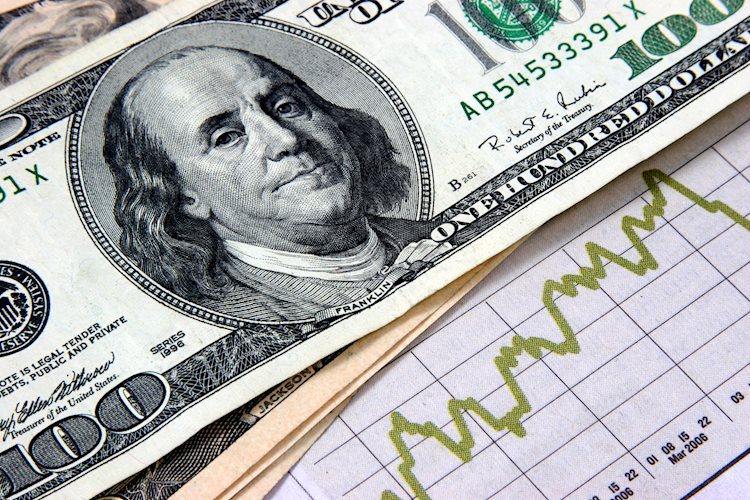- The DXY Index declined towards 103.70, seeing mild losses.
- US markets will remain closed on Thursday as the country celebrates Thanksgiving.
- The focus shifts to Friday’s S&P Global PMIs.
On Thursday, the US Dollar measured by the DXY index saw little downward movements. The markets are closed due to the Thanksgiving celebration, and the focus shifts to the S&P preliminary PMIs for November.
The United States economy showed that inflation and job creation cooled down in October, which was welcomed by Federal Reserve (Fed) officials. However, the Federal Open Market Committee (FOMC) Minutes from the November meeting and several officials warning that one month of positive data might not be enough to call it a victory means that the incoming data will determine the USD’s trajectory.
Daily Digest Market Movers: US Dollar loses further ground as investors bet on a dovish Fed despite warnings
- The US Dollar Index trades weak around 103.70.
- Despite warnings by the Fed, markets still bet on a less aggressive stance after the report of soft inflation figures from October.
- The US Bureau of Labor Statistics reported that October’s Core Consumer Price Index (CPI) missed the consensus. It came in at 4% YoY vs the expected 4.1% and decelerated from its previous figure of 4.1%.
- The headline figure came in at 3.2%YoY, below the consensus of 3.3% and in relation to its last reading of 3.7%.
- In addition, the Core Producer Price Index (PPI) from October fell short of expectations. It came in at 2.4% YoY vs the expected 2.7% and declined from its previous reading of 2.7%.
- The Federal Open Market Committee’s November Minutes revealed that officials were concerned about inflation and needed to see more evidence to be convinced that inflation is coming down.
- Markets are confident that the Federal Reserve won’t hike in December and are betting on rate cuts sooner than expected in May 2024. A sizable minority is even betting on a rate cut in March.
Technical Analysis: US Dollar sellers gain ground, eyes on bearish crossover
The indicators on the daily chart reflect a predominance of bearish momentum while revealing some remaining bullish potential. The Relative Strength Index (RSI) nearing oversold conditions may suggest exhausted selling pressure, with a potential turnaround in favour of buyers while the Moving Average Convergence Divergence (MACD) shows flat red bars.
Furthermore, the index position below the 20-day and 100-day Simple Moving Averages (SMAs) suggests that the selling momentum prevails in the short term, but the index above the 200-day SMA implies that the longer-term bullish trend could still influence it. However, a looming bearish crossover between the 20-day SMA and the 100-day SMA underscores the possibility of augmented selling momentum.
Support levels: 103.60 (200-day SMA), 103.30, 103.15.
Resistance levels: 104.00, 104.20 (100-day SMA),104.50.
Fed FAQs
Monetary policy in the US is shaped by the Federal Reserve (Fed). The Fed has two mandates: to achieve price stability and foster full employment. Its primary tool to achieve these goals is by adjusting interest rates.
When prices are rising too quickly and inflation is above the Fed’s 2% target, it raises interest rates, increasing borrowing costs throughout the economy. This results in a stronger US Dollar (USD) as it makes the US a more attractive place for international investors to park their money.
When inflation falls below 2% or the Unemployment Rate is too high, the Fed may lower interest rates to encourage borrowing, which weighs on the Greenback.
The Federal Reserve (Fed) holds eight policy meetings a year, where the Federal Open Market Committee (FOMC) assesses economic conditions and makes monetary policy decisions.
The FOMC is attended by twelve Fed officials – the seven members of the Board of Governors, the president of the Federal Reserve Bank of New York, and four of the remaining eleven regional Reserve Bank presidents, who serve one-year terms on a rotating basis.
In extreme situations, the Federal Reserve may resort to a policy named Quantitative Easing (QE). QE is the process by which the Fed substantially increases the flow of credit in a stuck financial system.
It is a non-standard policy measure used during crises or when inflation is extremely low. It was the Fed’s weapon of choice during the Great Financial Crisis in 2008. It involves the Fed printing more Dollars and using them to buy high grade bonds from financial institutions. QE usually weakens the US Dollar.
Quantitative tightening (QT) is the reverse process of QE, whereby the Federal Reserve stops buying bonds from financial institutions and does not reinvest the principal from the bonds it holds maturing, to purchase new bonds. It is usually positive for the value of the US Dollar.
